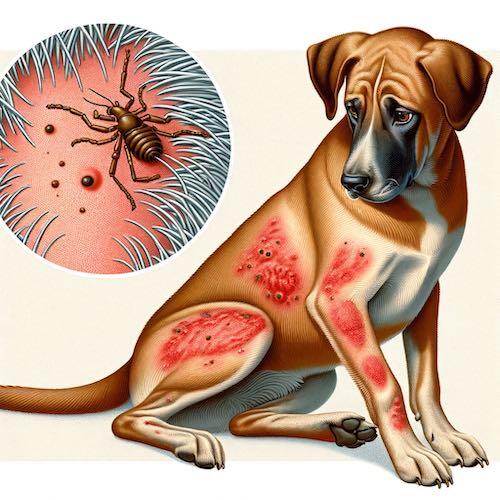Flea Rash on Dog Belly: Causes, Treatment, Relief
Seeing your dog relentlessly scratching their belly is heartbreaking. The sight of angry red bumps or irritated skin only adds to your concern. If you suspect fleas are the culprits, you’re likely right. Flea bites are notoriously itchy, and a dog’s sensitive belly is a prime target. The constant scratching can lead to a painful flea rash, leaving your furry companion miserable.
Understanding the causes of flea rashes is the first step towards providing your dog with the relief they desperately need. Flea Allergy Dermatitis (FAD) is a common reason for severe reactions to flea saliva. This allergy can cause intense itching, inflammation, and even hair loss.
Don’t worry, help is available! Effective treatments exist to combat flea rashes and provide your dog with much-needed relief. We’ll cover everything you need to know, including identifying the cause, seeking veterinary treatment options, and using at-home remedies to soothe your dog’s discomfort. Most importantly, we’ll discuss prevention strategies to keep those pesky fleas away for good!
Causes of Flea Rashes
Flea rashes on a dog’s belly, characterized by itchy, inflamed bumps, can significantly distress both pet and owner. While there are several factors that might cause skin irritation in dogs, the primary offender is often the presence of fleas. These tiny, blood-sucking parasites are not just a nuisance; they’re a source of considerable discomfort for your canine friend. Here’s a deeper look into the causes behind flea-induced skin irritations:
Flea Bites: The main issue begins when fleas, seeking a meal, bite your dog. The skin reaction is immediate, with each bite leaving a small, itchy, inflamed bump. Given the belly’s sparse fur coverage and tender skin, it’s an area that’s especially prone to developing a pronounced rash. The constant itching and discomfort can lead to a distressed state in your pet, affecting their overall wellbeing.
Flea Allergy Dermatitis (FAD): Beyond the typical irritation caused by flea bites, some dogs have an allergic reaction to the saliva of fleas, leading to flea allergy dermatitis (FAD). This allergic reaction is much more intense than the usual discomfort caused by flea bites, leading to excessive itching and skin inflammation. Dogs suffering from FAD may exhibit symptoms such as severe itching, red and inflamed skin, hair loss, and even the formation of open sores from relentless scratching and biting at the irritated areas. The condition can escalate quickly, making the dog miserable and leading to secondary skin infections if left untreated.
Fleas thrive in warm, humid environments, and their lifecycle allows them to become a persistent problem. A single flea can lay dozens of eggs a day, which fall off your pet and into your home, making the environment a reservoir for re-infestation. This cycle makes it crucial to address both the pet and its living environment in any flea control and treatment strategy. Understanding the cause of flea rashes and the potential severity of reactions like FAD is the first step in protecting your pet from these parasites and ensuring their skin remains healthy and irritation-free.
How to Tell It’s a Flea Rash
Identifying a flea rash amidst various skin conditions that can affect dogs requires attention to specific signs and symptoms. While several dermatological issues may present similarly, certain indicators strongly suggest that fleas are the culprits behind your dog’s discomfort. Here’s how you can discern a flea rash from other skin problems:
Location and Pattern: Flea rashes typically manifest in areas that provide fleas with easy access to the skin and some degree of cover. The belly, the base of the tail, and the inner thighs are prime spots for flea activity due to the thinner fur and the warmth these areas offer. A rash in these specific locations, especially if accompanied by excessive scratching or biting by your dog, strongly points towards fleas.
Presence of Flea Dirt: One of the most definitive signs of a flea infestation is the presence of flea dirt. These tiny black specks, which are actually flea feces, can often be found on your dog’s skin, in their fur, or within their bedding. When placed on a wet paper towel, flea dirt will dissolve into reddish-brown spots due to the blood content, providing a clear indication of flea activity on your pet.
Visual Confirmation of Fleas: Although fleas are small and quick, a careful examination might reveal these parasites navigating through your dog’s fur. Using a fine-toothed flea comb can help in spotting them, as the comb pulls fleas away from the skin and fur, making them easier to see. Observing live fleas or even flea eggs (tiny white specks) is a sure sign of infestation.
Behavioral Clues: Aside from physical signs, observing your dog’s behavior can also provide hints. Dogs with flea rashes may show signs of restlessness, exhibit unusual biting or scratching patterns, or even seem more irritable due to the constant itchiness. These behavioral changes, particularly if your dog focuses their scratching efforts on the aforementioned areas, further support the diagnosis of a flea rash.
Understanding these signs and knowing how to look for them can significantly aid in the early detection of flea infestations, allowing for prompt treatment. Early intervention not only alleviates your dog’s immediate discomfort but also prevents the situation from escalating into more severe allergic reactions or secondary infections.
Treatment
Eradicating fleas from your dog’s environment is the foundational step in addressing and preventing flea rashes. This involves not only treating your pet with veterinarian-approved flea control products but also extending the battle against fleas to your home. Thorough cleaning routines, including vacuuming and washing bedding at high temperatures, are essential to remove any lingering eggs and larvae that could lead to re-infestation. Flea treatments come in various forms, including topical solutions, oral medications, and collars, each designed to tackle flea problems effectively.
Search: Best Selling Flea Treatments
In addition to eradicating fleas, managing your dog’s discomfort is paramount. Veterinarians often recommend medicated baths using shampoos specifically formulated to soothe irritated skin and reduce inflammation. These products can offer immediate relief from itching, allowing the skin to begin the healing process.
For dogs suffering from intense itchiness, anti-itch medications, whether oral or topical, may be prescribed. These treatments work by targeting the allergic reaction and reducing the inflammatory response, thereby providing much-needed comfort to your pet.
Furthermore, relentless scratching can break the skin, creating entry points for bacteria and leading to secondary infections. In such cases, a course of antibiotics may be prescribed to combat the infection and prevent further complications. This comprehensive approach to treatment and prevention, combining flea eradication, skin care, and addressing secondary infections, ensures your pet can recover fully and remain comfortable and healthy. Through vigilant flea control and attentive care to the signs of discomfort in your dog, you can protect them from the distressing effects of flea infestations and related skin conditions.
Home Remedies for Relief
An Oatmeal Bath is a time-honored remedy known for its soothing properties, particularly effective in offering temporary relief from the relentless itchiness that plagues dogs with skin irritations or flea bites. Ground oatmeal, when dissolved in warm bath water, creates a milky, soothing soak that can help calm inflamed skin and alleviate discomfort, making it a gentle, natural way to provide your pet with immediate itch relief.
Using a Cool Compress is another simple yet effective method to bring down inflammation and soothe irritated skin. Gently applying a cloth soaked in cool water to the affected areas can significantly reduce swelling and provide a calming effect on hot spots or areas aggravated by scratching. This method is especially beneficial for acute flare-ups, offering instant relief without the need for medication.
Coconut Oil has gained popularity for its multifaceted benefits, including its ability to moisturize dry, irritated skin. Its mild, natural properties can help to nourish and restore the skin’s barrier, providing relief from dryness and itching. Coconut oil also possesses antibacterial qualities that can aid in preventing infections in compromised skin, making it a versatile addition to your pet’s skincare regimen.
Important Note: While these remedies can offer relief and support in managing your dog’s skin issues, they should not replace professional veterinary advice. Always consult with your veterinarian to ensure a proper diagnosis and to develop a comprehensive treatment plan tailored to your dog’s specific needs. Their expertise will guide you in choosing the most effective and safe approaches to address your pet’s health concerns.
Prevention is Key
Prevention is undoubtedly the cornerstone of managing flea-related issues effectively. To safeguard your beloved pet from the discomfort of flea rashes, it’s imperative to establish and adhere to a rigorous flea prevention regimen. This involves more than just occasional treatments; it means consistent, year-round measures designed to keep fleas at bay.
Engaging with your veterinarian is a critical step in this process. They can offer tailored advice on the most suitable flea preventative treatments considering your dog’s specific health needs, lifestyle, and the environmental factors specific to your geographical area. Options might include topical solutions, oral medications, flea collars, or even environment-friendly natural alternatives, each with its own set of advantages and application methods.
Your vet can provide insights into the peak flea seasons in your region and recommend adjustments to your prevention strategies accordingly. By integrating these preventative measures into your dog’s routine care, you can significantly reduce the risk of flea infestations, thereby minimizing the chances of flea rashes and ensuring your pet enjoys a happier, healthier life free from the irritations fleas bring.
Read More: How To Get Your Dog To Quit Barking: The Ultimate Guide To Controlling Excessive Barking



